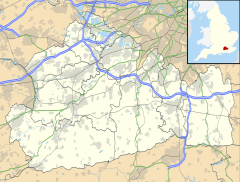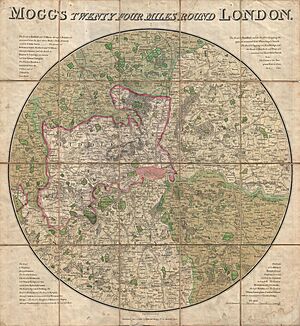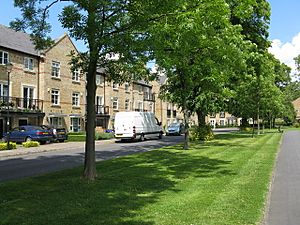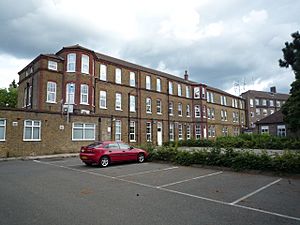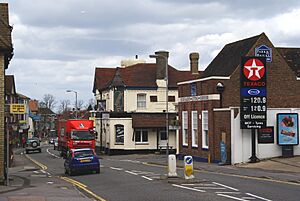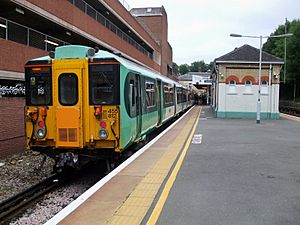Caterham facts for kids
Quick facts for kids Caterham |
|
|---|---|
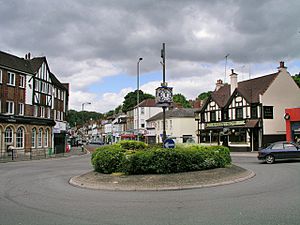 Roundabout in the centre of Caterham Valley |
|
| Area | 9.41 km2 (3.63 sq mi) |
| Population | 21,030 (2011 census) |
| • Density | 2,235/km2 (5,790/sq mi) |
| OS grid reference | TQ3456 |
| Civil parish |
|
| District |
|
| Shire county | |
| Region | |
| Country | England |
| Sovereign state | United Kingdom |
| Post town | Caterham |
| Postcode district | CR3 |
| Dialling code | 01883 |
| Police | Surrey |
| Fire | Surrey |
| Ambulance | South East Coast |
| EU Parliament | South East England |
| UK Parliament |
|
Caterham (pronounced KAY-tər-əm) is a town in the Tandridge area of Surrey, England. The town is split into two main parts: Caterham on the Hill and Caterham Valley. Caterham Valley has the main town centre and is located in a dry valley. Caterham on the Hill is higher up, on a hill to the west.
The town is near the A22 main road. It is about 21 miles (34 km) from Guildford and 6 miles (10 km) south of Croydon. Caterham is in a valley that cuts into the side of the North Downs hills.
Contents
Discovering Caterham's History
Ancient Times
On top of White Hill, in Caterham Valley, there's an old camp called The Cardinal's Cap. This was once a large hillfort, a type of ancient fort built on a hill. Archaeologists have studied it and found that it was used during the Iron Age. The fort had strong banks and ditches to protect it.
Caterham is also part of an old Anglo-Saxon area called Tandridge hundred.
After the Norman Conquest
Caterham's church, St Lawrence, was built during the Norman period. For a long time, the church and its lands were owned by a monastery called Waltham Holy Cross. They managed these lands like a manor, which is a large estate.
The original village centre of Caterham was on the hill, in the area now known as Caterham on the Hill. This part of town has older buildings, including The King and Queen pub and several churches.
Manors and Land Ownership
Over the centuries, different powerful families and individuals owned parts of Caterham. These large estates were called manors. One important manor was called Porkele. Another was the Manor of Salmons. These manors changed hands many times, often through sales or inheritance.
For example, the De Stafford School in Caterham on the Hill is named after an early owner of one of these estates, Humphrey Stafford.
After the Reformation
After the English Reformation, when the monasteries were closed, the land in Caterham was given to new owners by the King. These lands continued to be bought and sold by different families, including important figures like Thomas Sackville, who was a Lord High Treasurer.
The Victorian Era and Beyond
In the early 1800s, Caterham was a small place with about 477 residents. A lot of its land was common land, meaning it could be used by everyone.
The modern part of Caterham, known as Caterham Valley, grew a lot during the Victorian age. This happened especially after the Caterham railway line opened in 1856. The railway made it easier for people to travel to and from Caterham, helping the town grow.
As the town expanded, new churches were built. The Church of St Mary the Virgin was built in 1866, and St. John the Evangelist was built in 1882.
From 1877, Caterham Barracks on the hill was a training base for soldiers, especially the Foot Guards. The barracks closed in 1995, and the area was turned into homes.
Caterham has two main areas, Caterham on the Hill and Caterham Valley, each with its own shops and community feel. The Godstone Road was built to bypass Caterham Valley, which helped local businesses in the valley to thrive.
Geography of Caterham
Caterham is about 21 miles (34 km) from Guildford and 15.5 miles (25 km) south of London.
Caterham on the Hill is located on high ground that stretches north towards Kenley Aerodrome. This elevated area continues west towards Hooley. East of Caterham Valley are the rolling hills of the North Downs.
The M25 motorway passes south of Caterham Valley. It is linked to the town by a main road.
Hills and Landscape
In the south of Caterham, you can find some notable hills:
| Hill | Elevation |
|---|---|
| Gravelly Hill | 236m |
| White Hill | 233m |
The lowest point in Caterham is about 110 meters (360 feet) above sea level, near the railway track. The highest points are around 236 meters (774 feet).
Caterham is located within the North Downs area. The North Downs Way, a popular walking trail, runs along the southern edge of the North Downs, very close to Caterham Valley.
The soil in Caterham is often shallow and rich in lime, especially over the chalk and limestone areas. In other places, the soil can be slightly acidic and good for farming. The area's geology includes chalk, clay, and greensand, which were formed millions of years ago.
Important Landmarks
The North Downs Way is a famous walking trail that passes very close to Caterham. You can easily reach it from Harestone Valley Road or Tupwood Lane.
Other landmarks include The Cardinal's Cap, which is the ancient hillfort mentioned earlier. There is also Fosterdown or Pilgrims' Fort, which was a defensive fort built to protect London.
Whitehill Tower is a unique building, or "folly," built in 1862 by a local landowner named Jeremiah Long. It is located near War Coppice Road.
Parts of Caterham
Caterham Valley
Caterham Valley is the part of town with the main shopping area and town centre. About 7,581 people live here.
The parish church of St. John the Evangelist was built in 1882. The Caterham railway station is at the end of the railway line in the middle of this area. The A22 bypass, opened in 1939, helps route traffic around the town centre.
Caterham School is a large independent school located in the Harestone Valley. North Downs Hospital is a small private hospital on the edge of town. Caterham Valley also has a business community group called Caterham Valley For You. The local police station and St John Ambulance unit are also in the valley.
Caterham on the Hill
Caterham on the Hill is the other main part of Caterham. It is located to the northwest of Caterham Valley. It has a population of 11,555 and was the original settlement in the area, so it has more historic buildings.
The only state secondary school, de Stafford School, is in this part of town. There are also two private primary schools.
Former Barracks
The site of the former Caterham Barracks is now used for various facilities. It includes a supermarket, homes, an arts centre called The Arc, and an indoor Skate park called Skaterham. Skaterham is located in the old Guard's chapel.
Famous people like Terry Waite and David Stirling (who founded the SAS) trained at the barracks. Some films and TV shows, such as They Were Not Divided and Invasion: Earth, were also filmed there.
Hospitals
Caterham Asylum, later known as Saint Lawrence's Hospital, was once a very large hospital for people with mental health conditions. Most of this site has now been turned into housing.
Caterham on the Hill also has a small NHS hospital called Caterham Dene. It offers various services, including a minor injury unit.
People and Homes
In 2011, Caterham had a total population of 21,090 people living in 8,543 homes.
Here's a look at the types of homes in Caterham in 2011:
| Output area | Detached | Semi-detached | Terraced | Flats and apartments |
|---|---|---|---|---|
| Caterham on the Hill | 1,185 | 1,666 | 963 | 1,208 |
| Caterham Valley | 1,034 | 854 | 229 | 1,393 |
Many homes in Caterham are owned by the people who live in them, either outright or with a loan.
Shops and Businesses
Church Walk
Church Walk Shopping Centre is a small shopping mall located across from Caterham railway station in Caterham Valley. It was built on the site of the old Valley Hotel.
Local Companies
Caterham Cars, which makes the Caterham 7 sports car, used to have its offices and factory in Caterham until 1987. The company later moved its showroom out of town.
Croudace, a house building company, has its main office in Caterham. Schools like Caterham and De Stafford, along with several supermarket chains, are also big employers in the area.
The High Street in Caterham on the Hill has many small, independent shops. Parking is free for three hours in the main car park.
Getting Around
Caterham railway station is the last stop on the Caterham line, which opened in 1856. Trains from Caterham go to London Bridge.
Eight bus routes operate through Caterham. Some are run by Metrobus, connecting Caterham to places like East Grinstead, Croydon, Redhill, and Oxted. Other bus companies also run routes to nearby towns.
Sports in Caterham
Caterham has a youth football club called Caterham Pumas FC. The Old Caterhamians Rugby Football Club was started in 1928. Caterham Cricket Club shares facilities with the rugby club. Caterham Sea Cadets, formed in 1942, enjoy water sports.
Caterham Pumas Football Club plays its matches at Joliffe Playing Field. They have teams for children from under six to under eighteen, as well as two adult teams.
Media
Television signals in Caterham come from the Crystal Palace TV transmitter. This means residents can watch BBC London and ITV London programmes.
The town is served by local radio stations like BBC Radio Surrey and BBC Radio London. Other stations include Heart South, Greatest Hits Radio Surrey & North-East Hampshire, and Ridge Radio, which is a community station broadcasting from Caterham.
Local newspapers for the town are The Caterham Independent and Caterham Mirror.
Education
Caterham has both state (public) and private schools. Three private schools are Caterham School, Oakhyrst Grange School, and Essendene Lodge School. Caterham School has been at its current site since 1884.
The main state secondary school is de Stafford School. There is also a special secondary school for boys with special educational needs called Sunnydown School in Caterham on the Hill.
Culture and Community
Caterham offers various activities for young people. There's a children's ball pit and gymnastics centre located in the old Caterham Barracks housing estate. The building used to be two gymnasiums.
There is also a skatepark called "Skaterham" in Caterham on The Hill. It has both indoor and outdoor sections and is built on the grounds of the former Guards Chapel.
The Miller Centre, located in the town centre, is a theatre and community hub. It hosts plays, films, and various clubs and groups. Croydon Gymnastics Club is based in the gymnastics centre on the high street.
The small East Surrey Museum has a collection of local history items.
An annual carnival is held in Caterham, featuring a procession of floats and a fete (a type of outdoor festival).
Caterham has its own online radio station for the community, called Ridge Radio.
The first Caterham Festival took place in 2009. By 2014, it had grown to include 135 events over five weeks. The festival includes a two-day music fest, a street party where the High Street is closed, and a food festival. Other events include Shakespeare plays, archaeological digs, concerts, and comedy nights. The annual Carnival is also part of the Festival. The Festival has won several awards for its community efforts.
Religion
Caterham has churches for different Christian groups. The oldest church still in use is St. Lawrence, which was built around 1095. It has been used by various denominations over time. It was mostly replaced by the church of St. Mary the Virgin, built in 1866. Both of these older churches are in Caterham on the Hill.
As Caterham Valley grew, new churches were built there too. Caterham United Reformed Church was built in 1863, followed by the Church of St. John the Evangelist in 1881.
Famous People from Caterham
Many notable people have connections to Caterham:
- The composer Mátyás Seiber lived in Caterham from 1935 until his death in 1960.
- Television presenter Angus Deayton grew up in Caterham and attended Oakhyrst Grange and Caterham Schools.
- Footballers Nicky Forster and David Price, and cricketer Dar Lyon, were all born in the town.
- Actors Bill Nighy and Jon Finch were also born in Caterham.
- Actor Michael Robbins passed away in Caterham.
Images for kids
See also
 In Spanish: Caterham (Surrey) para niños
In Spanish: Caterham (Surrey) para niños


